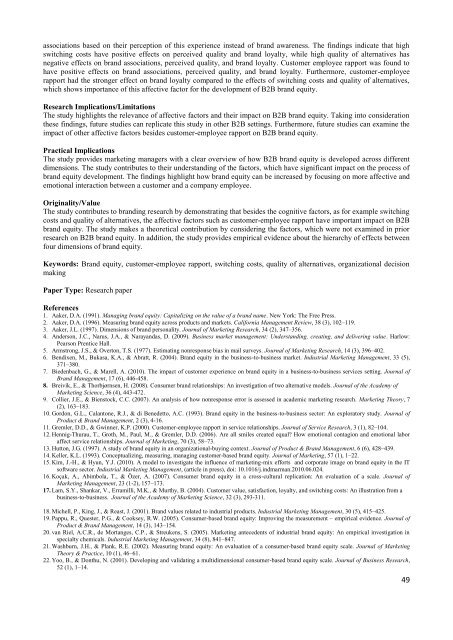Brand, Identity and Reputation: Exploring, Creating New Realities ...
Brand, Identity and Reputation: Exploring, Creating New Realities ...
Brand, Identity and Reputation: Exploring, Creating New Realities ...
Create successful ePaper yourself
Turn your PDF publications into a flip-book with our unique Google optimized e-Paper software.
associations based on their perception of this experience instead of br<strong>and</strong> awareness. The findings indicate that high<br />
switching costs have positive effects on perceived quality <strong>and</strong> br<strong>and</strong> loyalty, while high quality of alternatives has<br />
negative effects on br<strong>and</strong> associations, perceived quality, <strong>and</strong> br<strong>and</strong> loyalty. Customer employee rapport was found to<br />
have positive effects on br<strong>and</strong> associations, perceived quality, <strong>and</strong> br<strong>and</strong> loyalty. Furthermore, customer-employee<br />
rapport had the stronger effect on br<strong>and</strong> loyalty compared to the effects of switching costs <strong>and</strong> quality of alternatives,<br />
which shows importance of this affective factor for the development of B2B br<strong>and</strong> equity.<br />
Research Implications/Limitations<br />
The study highlights the relevance of affective factors <strong>and</strong> their impact on B2B br<strong>and</strong> equity. Taking into consideration<br />
these findings, future studies can replicate this study in other B2B settings. Furthermore, future studies can examine the<br />
impact of other affective factors besides customer-employee rapport on B2B br<strong>and</strong> equity.<br />
Practical Implications<br />
The study provides marketing managers with a clear overview of how B2B br<strong>and</strong> equity is developed across different<br />
dimensions. The study contributes to their underst<strong>and</strong>ing of the factors, which have significant impact on the process of<br />
br<strong>and</strong> equity development. The findings highlight how br<strong>and</strong> equity can be increased by focusing on more affective <strong>and</strong><br />
emotional interaction between a customer <strong>and</strong> a company employee.<br />
Originality/Value<br />
The study contributes to br<strong>and</strong>ing research by demonstrating that besides the cognitive factors, as for example switching<br />
costs <strong>and</strong> quality of alternatives, the affective factors such as customer-employee rapport have important impact on B2B<br />
br<strong>and</strong> equity. The study makes a theoretical contribution by considering the factors, which were not examined in prior<br />
research on B2B br<strong>and</strong> equity. In addition, the study provides empirical evidence about the hierarchy of effects between<br />
four dimensions of br<strong>and</strong> equity.<br />
Keywords: <strong>Br<strong>and</strong></strong> equity, customer-employee rapport, switching costs, quality of alternatives, organizational decision<br />
making<br />
Paper Type: Research paper<br />
References<br />
1. Aaker, D.A. (1991). Managing br<strong>and</strong> equity: Capitalizing on the value of a br<strong>and</strong> name. <strong>New</strong> York: The Free Press.<br />
2. Aaker, D.A. (1996). Measuring br<strong>and</strong> equity across products <strong>and</strong> markets. California Management Review, 38 (3), 102–119.<br />
3. Aaker, J.L. (1997). Dimensions of br<strong>and</strong> personality. Journal of Marketing Research, 34 (2), 347–356.<br />
4. Anderson, J.C., Narus, J.A., & Naray<strong>and</strong>as, D. (2009). Business market management: Underst<strong>and</strong>ing, creating, <strong>and</strong> delivering value. Harlow:<br />
Pearson Prentice Hall.<br />
5. Armstrong, J.S., & Overton, T.S. (1977). Estimating nonresponse bias in mail surveys. Journal of Marketing Research, 14 (3), 396–402.<br />
6. Bendixen, M., Bukasa, K.A., & Abratt, R. (2004). <strong>Br<strong>and</strong></strong> equity in the business-to-business market. Industrial Marketing Management, 33 (5),<br />
371–380.<br />
7. Biedenbach, G., & Marell, A. (2010). The impact of customer experience on br<strong>and</strong> equity in a business-to-business services setting. Journal of<br />
<strong>Br<strong>and</strong></strong> Management, 17 (6), 446-458.<br />
8. Breivik, E., & Thorbjørnsen, H. (2008). Consumer br<strong>and</strong> relationships: An investigation of two alternative models. Journal of the Academy of<br />
Marketing Science, 36 (4), 443-472.<br />
9. Collier, J.E., & Bienstock, C.C. (2007). An analysis of how nonresponse error is assessed in academic marketing research. Marketing Theory, 7<br />
(2), 163–183.<br />
10. Gordon, G.L., Calantone, R.J., & di Benedetto, A.C. (1993). <strong>Br<strong>and</strong></strong> equity in the business-to-business sector: An exploratory study. Journal of<br />
Product & <strong>Br<strong>and</strong></strong> Management, 2 (3), 4-16.<br />
11. Gremler, D.D., & Gwinner, K.P. (2000). Customer-employee rapport in service relationships. Journal of Service Research, 3 (1), 82–104.<br />
12. Hennig-Thurau, T., Groth, M., Paul, M., & Gremler, D.D. (2006). Are all smiles created equal? How emotional contagion <strong>and</strong> emotional labor<br />
affect service relationships. Journal of Marketing, 70 (3), 58–73.<br />
13. Hutton, J.G. (1997). A study of br<strong>and</strong> equity in an organizational-buying context. Journal of Product & <strong>Br<strong>and</strong></strong> Management, 6 (6), 428–439.<br />
14. Keller, K.L. (1993). Conceptualizing, measuring, managing customer-based br<strong>and</strong> equity. Journal of Marketing, 57 (1), 1–22.<br />
15. Kim, J.-H., & Hyun, Y.J. (2010). A model to investigate the influence of marketing-mix efforts <strong>and</strong> corporate image on br<strong>and</strong> equity in the IT<br />
software sector. Industrial Marketing Management, (article in press), doi: 10.1016/j.indmarman.2010.06.024.<br />
16. Koçak, A., Abimbola, T., & Özer, A. (2007). Consumer br<strong>and</strong> equity in a cross-cultural replication: An evaluation of a scale. Journal of<br />
Marketing Management, 23 (1-2), 157–173.<br />
17. Lam, S.Y., Shankar, V., Erramilli, M.K., & Murthy, B. (2004). Customer value, satisfaction, loyalty, <strong>and</strong> switching costs: An illustration from a<br />
business-to-business. Journal of the Academy of Marketing Science, 32 (3), 293-311.<br />
18. Michell, P., King, J., & Reast, J. (2001). <strong>Br<strong>and</strong></strong> values related to industrial products. Industrial Marketing Management, 30 (5), 415–425.<br />
19. Pappu, R., Quester, P.G., & Cooksey, R.W. (2005). Consumer-based br<strong>and</strong> equity: Improving the measurement – empirical evidence. Journal of<br />
Product & <strong>Br<strong>and</strong></strong> Management, 14 (3), 143–154.<br />
20. van Riel, A.C.R., de Mortanges, C.P., & Streukens, S. (2005). Marketing antecedents of industrial br<strong>and</strong> equity: An empirical investigation in<br />
specialty chemicals. Industrial Marketing Management, 34 (8), 841–847.<br />
21. Washburn, J.H., & Plank, R.E. (2002). Measuring br<strong>and</strong> equity: An evaluation of a consumer-based br<strong>and</strong> equity scale. Journal of Marketing<br />
Theory & Practice, 10 (1), 46–61.<br />
22. Yoo, B., & Donthu, N. (2001). Developing <strong>and</strong> validating a multidimensional consumer-based br<strong>and</strong> equity scale. Journal of Business Research,<br />
52 (1), 1–14.<br />
49
















